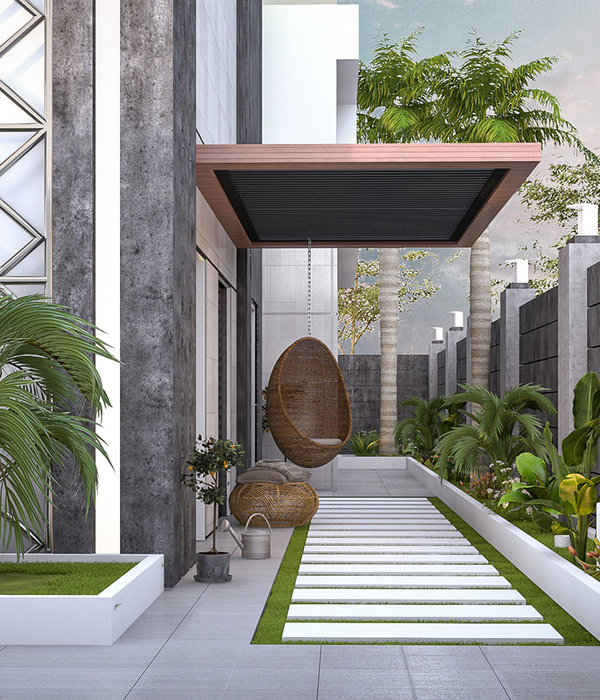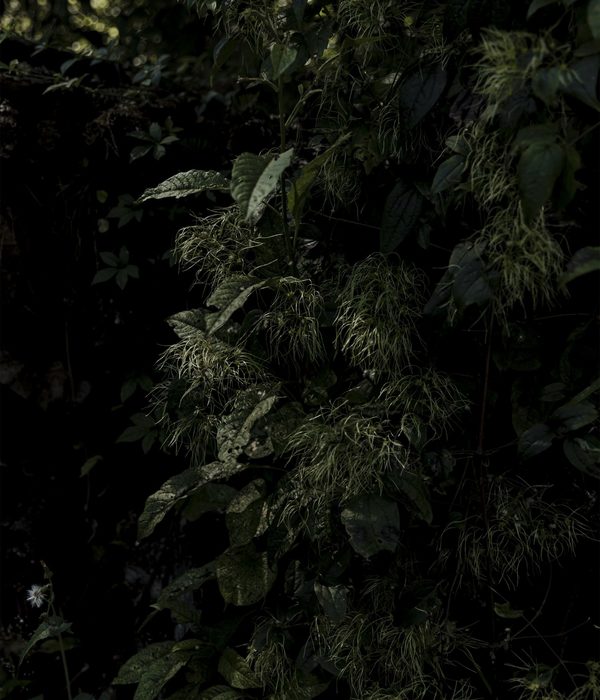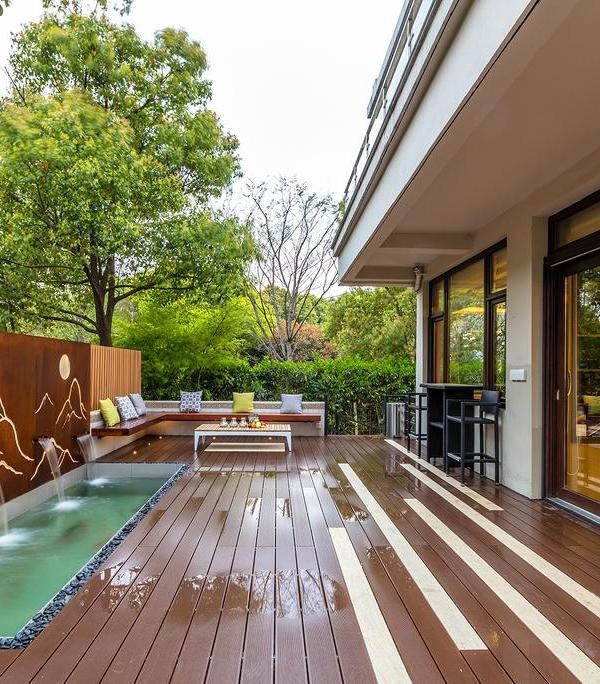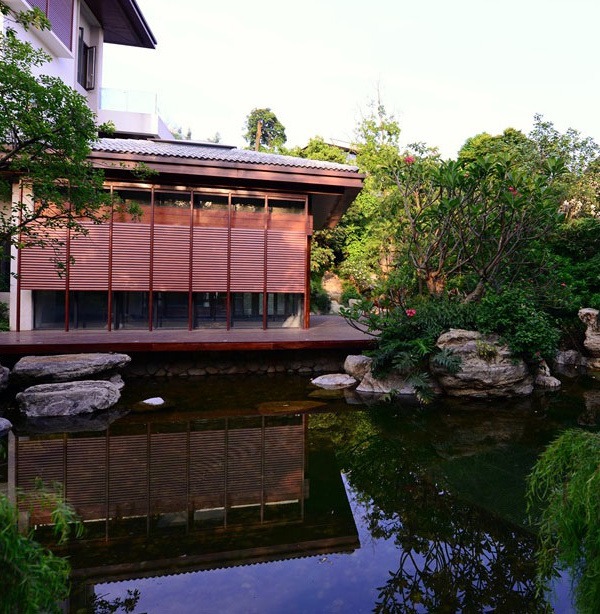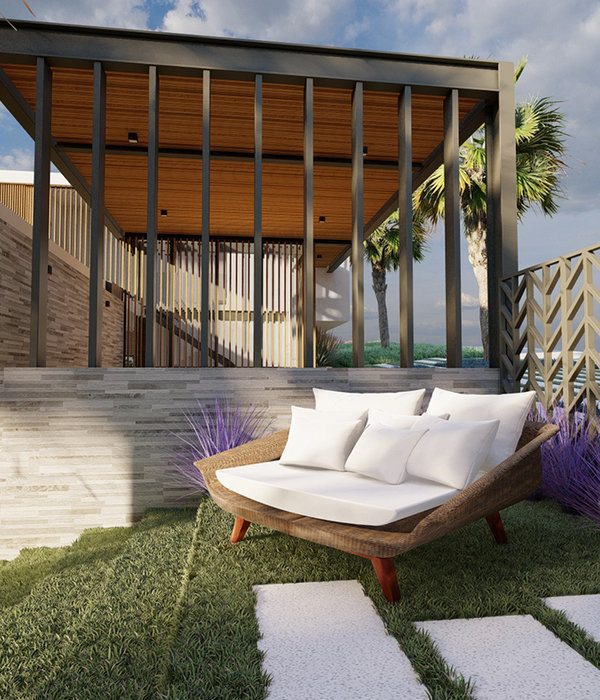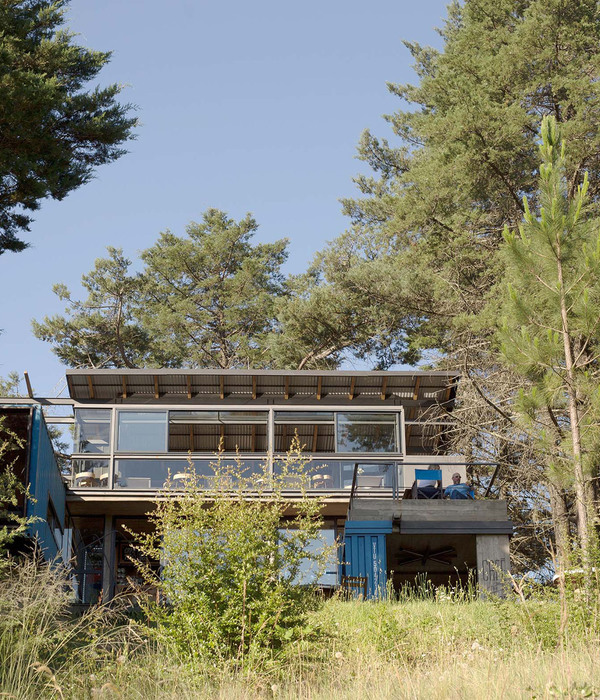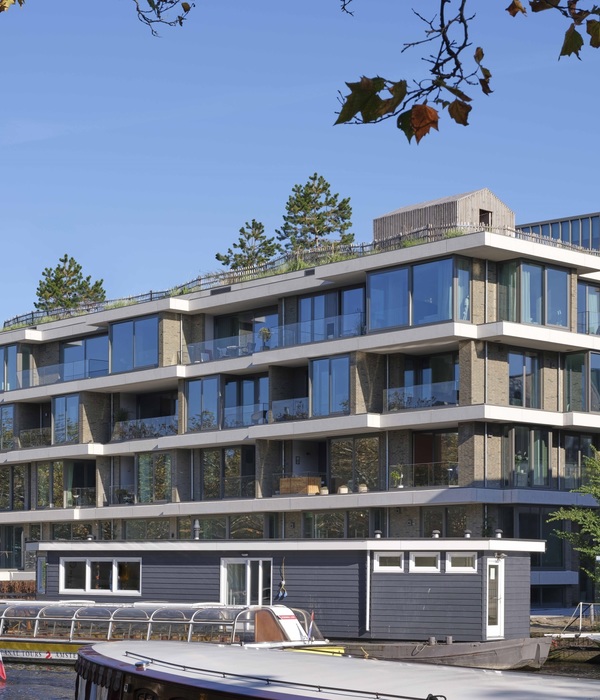Chris的妻子兼合伙人Fei Precht补充道:“我们之所以做这个‘农场’项目,其实是出于我们自身的兴趣。两年前,我们将办公室从北京的市中心迁至奥地利的山区。现在,我们在一个远离城市的地方生活和工作,希望能够尽可能地实现一种自给自足的生活。大多数的食物都是我们自己种的,剩下的则是从附近的农民那里获得的。现在,我们与食物的关系变得非常与众不同。相信我,自己种出来的番茄的味道,与从其他地区或国家进口来的是十分不同的。我们意识到,这种生活方式并不是所有人都能享受到的,因此我们开始尝试进行项目的开发,希望能够将食物带回到城市中去。”
His wife and partner Fei Precht adds: ”Our motivation for ‘the Farmhouse’ is personal. 2 years ago we relocated our office from the centre of Beijing to the mountains of Austria. We live and work now off the grid and try to be as self-sufficient as somehow possible. We grow most of the food ourselves and get the rest from neighbouring farmers. We have now a very different relation to food. A tomato from your garden tastes different then the one shipped around the globe. We are aware that this life-style is not an option for everyone, so we try to develop projects, that brings food back to cities.”
“在这个体系下,食物的生产线变得清晰明了,”Precht说道。“它不仅将农业重新置入进城市的中心地带,更将这种农业生态系统的概念根植于我们的脑海中。食物是我们日常生活中不可或缺的一部分,因此,我将这座‘农场’视为一种教育模式,让大众能够清晰地看到我们的食物的来源以及其生产和加工的过程。”
“This process of food production becomes visible,” says Precht. “It reenters the centre of our cites and the centres of our minds. Food is an important part of our daily life and I see ‘the Farmhouse’ as an educational statement that it’s no longer a mystery where our food comes from and how it lands on our table.”
在过去的两年中,我们的工作室研究开发了一个模块化的建筑系统,用于研究人类与食物之间的关系,并通过这个系统设计了一个将建筑与农业联系起来的大楼。
For the last 2 years, our studio developed a modular building system that investigates the connection of people with their food and creates a building that connects architecture with agriculture.
▼项目外观,exterior view
背景概述 | Premiss
在过去的两个世纪里,我们已经与我们的食物脱节了。几千年以来,人类都与他们的食物和城市交织在一起。农业的诞生不仅催生出我们的第一个永久聚落,同时,它也随着人们对食物和宜居地的需求的增长而不断发展。然而,随着工业革命的到来,这种状态发生了改变。人类在交通运输业和食物储存方面取得的进步使得他们能够更快地运输且更好地保存货物。因此,农耕的过程逐渐从我们的视线中消失了。
During the last 2 centuries we became disconnected from our food. For thousands of years, people, their food and cities were intertwined. The beginning of farming gave birth to our first permanent settlements and both grew, hand in hand, with the demand for more food and more liveable areas. With the industrial revolution this changed. Advances in transportation and preservation made it possible to deliver goods faster and store them longer. The process of growing food moved out of our sights and out of our minds.
▼项目外观,木材和植被构建出一个城市中的垂直农场,exterior view, wood and plants create a vertical Farmland in the urban environment
从那时起,农业与建筑的土地和资源争夺战就从未停歇。人们对粮食产量增长的需求和他们对利益的贪婪使得我们的自然栖息地濒临破坏。目前,建筑和农业是两个最大的污染源,据统计,全世界有90%的人口都在呼吸着受污染的空气。建筑和农业已经成了对我们有害的事物。这种不健康的生活环境和人们越来越单一的饮食习惯甚至导致了肥胖、糖尿病、心脏病和癌症等疾病。
Since then, agriculture and architecture battle for territory and resources. The need for growth and the greed for profitability brought our natural habitat to the brink of existence. The building and the agriculture sector are the two largest polluting industries and each day, 90% of the world’s population breathes polluted air. Both sectors became harmful to us. Obesity, diabetes, heart disease and lung cancer are an outcome of a one-sided diet and an unhealthy environment.
▼项目外观,垂直农场将城市区域打造为农村有机循环的一部分,exterior view, the vertical Farmhouse makes urban areas become part of an organic loop with the countryside
食物和住所都是人类的需求,建筑师需要重新思考这二者之间的关系。如今,建筑师有机会去重新构建建筑和农业之间的关系,将其变成两个互惠互利、相辅相成的概念。“我认为,我们之前都忽视了建筑和农业与自然界之间在身体上和精神上的联系,我希望这个项目可以像催化剂一般,重新构建人类与其环境生命周期之间的联系,” Chris Precht说道。
But food and shelter are human needs and architects can rethink their relation. There is an opportunity to reconnect architecture and agriculture and change them to the betterment of both. “I think we miss this physical and mental connection with nature and this project could be a catalyst to reconnect ourselves with the life-cycle of our environment,” says Chris Precht.
▼俯视外观,垂直农场创造出堆叠形式的种植花园,exterior view looking down, the vertical farmhouse creates stacked gardens
农场 | The Farm
在接下来的50年中,人类所消耗的食物将超过过去10,000年的总和,这其中有80%的消耗都来自城市。很明显,我们需要找到一种替代性的生态系统,从而取代现有的食物供应系统,即我们种什么、在哪儿种,吃什么、在哪儿吃等。对于这个新型系统来说,有机农业、无公害的肉类、社会性采购和“从农场到餐桌”生鲜电商策略等因素至关重要。这就意味着需要将我们的城市区域打造为农村有机循环的一部分,以满足人口对食物的需求,同时为城市提供食品安全。
In the next 50 years more food will be consumed than in the last 10,000 years combined and 80% will be eaten in cities. It is clear that we need to find an ecological alternative to our current food system. What and where we grow and eat. Topics like organic agriculture, clean meat, social sourcing and ‘farm to table’ will be key elements of this change. That means that our urban areas need to become part of an organic loop with the countryside to feed our population and provide food security for cities.
▼项目外观局部,堆叠形式的种植花园实现了城市生态的自我复原,partial exterior view, stacked gardens allow used farmland to naturally restore itself
如果可以将食物的生长空间限定在一个区域内,那么供应链和包装链便可以适当地缩减。堆叠形式的种植花园使得人们不再需要费尽心机地将城市用地转变为森林、热带草原和红树林等,而是通过这些使用中的农耕用地,顺其自然地完成城市生态的自我复原。垂直农场可以在占地面积相同的情况下,提高每片种植区的粮食产量。而室内的温室气候则可以使农作物免受不同天气状况的影响,同时为不同的植物提供不同的生态系统。
If food is grown within the region, the supply chain and the use of packaging gets shortened. Stacked gardens reduce the need to convert forests, savannahs and mangroves and allows used farmland to naturally restore itself. Vertical farms can produce a higher ratio of crop per planted area. The indoor climate of greenhouses protect the food against varying weather conditions and offers different eco- systems for different plants.
▼项目外观局部,将农场融入城市,partial exterior of the Farmhouse, re-introducing the farm into the city
此外,建筑师所构想的农场项目在建筑内部也产生了一个附属的有机生命周期,即一个过程的产出可作为另一个过程的原料:建筑物所产生的大量热可以被土豆、坚果和豆类植物等利用,促进其生长。水处理系统可以过滤雨水和洗涤水,并将营养素注入其中,之后再将处理后的水体循环回温室内。而食物垃圾则可以通过建筑的地下室进行当场回收和处理,使其变成肥料,以促进更多农作物的生长和产出。
Our Farmhouse runs on an organic life-cycle of byproducts inside the building, where one processes output is another processes input: Buildings create already a large amount of heat, which can be reused for plants like potatoes, nuts or beans to grow. A water-treatment system filters rain- and greywater, enriches it with nutrients and cycles it back to the greenhouses. The food waste can be locally collected in the buildings basement, turned into compost and reused to grow more food.
▼项目外观局部,partial exterior view
建筑 | The House
农场项目的初衷是鼓励市民在其生活的空间内种植食物,但与此同时,项目在建筑层面上的表达也使得这种生态系统得以延续。“在某种程度上,我们不仅‘建造’了我们的农田,同时‘种植’了我们的建筑。”树木为农场提供了主要的建筑材料。项目的模块化结构系统、饰面和花架花槽皆由交叉层压木板构成。事实上,使用交叉层压木板具有很多的益处,如其具有制造方面的精确性,且易于运输和安装。此外,在生活空间中加入木材还具有生态效益,即树木是利用天然能源生长的。数据表明,使用木材生产结构型板材产品所需的能量要远远低于使用钢、水泥和混凝土等材料,同时,在制造过程中其所产生的温室气体也远低于钢、水泥和混凝土等。另外,木材本身就可以吸收二氧化碳,因此,与其他建筑材料相比,它具有更低的碳排放量,从而对环境所造成的影响也就更小。
The foundation of the Farmhouse is to encourage citizens to grow food locally, but it also continues this ecological aspect with its architecture. “In a way, we construct our farmland and we plant our building.” Trees provide the main building material for the Farmhouse. Cross Laminated Timber panels are used to develop the modular system of structure, finishes and planters. Working with CLT has a lot of benefits. It is precise to fabricate, easy to transport and quick to install. Living with wood has also ecological benefits: Trees grow by a natural source of energy. The process that creates structural engineered wood products takes far less energy than steel, cement or concrete and produces fewer greenhouse gases during manufacturing. Further, wood stores carbon in itself (approximately one tone per cubic meter) thus it has, compared to other building materials, a lighter overall environmental footprint.
▼项目外观局部,在倾斜的墙壁上种植绿植,partial exterior view, planting vegetations on the angled walls
农场项目由一个完全模块化的建筑系统组成,预制过程在场地之外的场所进行,待到预制过程完成后,便将每一块木板都水平叠放,由卡车运至基地。这种预制的模块化建筑构件套组缩短了整个施工周期,也减小了其对周边环境所造成的影响。建筑系统采用传统的A字型结构框架,同时与传递建筑荷载的斜肋构架相连。每个结构框架的墙体都由三层空间组成:一个包含着饰面、电路系统和管道系统的内层、一个包含着结构框架和保温隔热层的中间层,以及一个包含着花园元素和供水系统的外层等。
▼农场垂直生长过程,vertical growth process of the Farmhouse
The Farmhouse consists of a fully modular building system, which is prefabricated offsite and flat- packed delivered by trucks. Prefabrication of a modular building kit shortens the time for construction and its affect on the surrounding. The building system is based on structural clarity of traditional A-Frame houses and connects to a diagrid that runs the loads through the building. Each wall of the frame exists of 3 layers. An inside layer with finishes, electricity and pipes, a middle layer with structure and insulation and an outside layer with gardening elements and water supply.
▼A字型结构框架单体生成过程,growth process of the A-Frame house unit
对于独栋住宅来说,这个建筑系统为住户提供了一种设计思路,他们可以根据对生活空间和耕种空间的需求,自行设计自己的空间。比如,住户们可以从结构和花园系统、废物处理单元、水处理系统、水耕法以及太阳能系统等中任选一项或几项,通过不同的排列和组合创造出一系列具有一定灵活性的空间布局。此外,DIY的设计手法在本项目中也发挥着至关重要的作用。它不仅有助于建筑花园空间的设计,更有利于其自身的施工过程。住户可以根据他们自己想要的空间布局进行小屋的建设,从而打造出一种自给自足的、真正舒适的居住环境。
For single-family structures, this systems gives a tool to home-owners to design their own place, based on the needs and the demands to living and farming. Structural and gardening elements, waste management units, water treatment, hydroponics and solar systems can be selected from a catalog of modules and offers a certain flexibility for various layouts. The hands-on approach of the DIY movement played a big role in the design. Not only for the gardening part of the building, but also for its construction. This method allows owners to self- construct their tiny houses based on their chosen layout. Architecture that is home-built with food that is home-grown.
▼A字型结构框架单体构成不同的空间,different spaces formed by the A-Frame house units
▼A字型结构框架单体构成的生活空间,the living space formed by the A-Frame house unit
▼A字型结构框架组合,形成一个独栋住宅,the assembly formed by the A-Frame house unit, creating a sing-family house
另外,人们还可以将这个A字型框架的空间进行组合,从而组装出一个更高更大的双层空间:首层具有一个宽敞的开放式空间,作为公寓的起居室和厨房,而二层则是一个帐篷般的空间,作为卧室和卫生间。倾斜的墙体为住宅外部的种植需求提供了空间,同时在不同的公寓之间创造出一个V字型的缓冲区。同时,这种设计手法也使得室内环境享有自然采光和自然通风。通过组合得到的住所空间在建筑与其周边的自然环境之间建立起一个直接的联系,从而在遍布着混凝土体块的城市空间中脱颖而出。这是一个被大自然所环绕着的住所,空间中蕴含着道家“阴阳”的概念,多彩的花园和健康的室内环境为住户提供了一个世外桃源般的家。
Taller structures are assembled as duplex-sized A-frames, which provide a large open space on the first floor for a living-room and kitchen and a tent-like space on the second floor for bedrooms and bathrooms. The angled walls give space for gardening on their outside and create a V-shaped buffer zone between the apartments. This also lets natural ventilation and natural light into the building. The building invokes a direct connection with a natural surrounding, that stands apart from the concrete landscape of our cities. A tent that is surrounded by nature. A Yin&Yang of colourful gardens and healthy interiors.
▼多个A字型结构框架组合,形成社区型空间,the assembly formed by several A-Frame house unit, creating a community space
农场的花园不仅可以作为居民的私人空间进行种植活动,还可以服务于一个更大的社区空间,使得人们可以共同耕种,从而获取他们所需的蔬菜和香草草药等。当丰收季来临时,人们可以在大楼下层的室内农贸市场中共享或出售自己收获的果实。同时,还能够以单座建筑内的生态循环为核心,在大楼内设置教育类课程、 地窖和肥料单元等。
The gardens can be used privately for residents to grow their own food, or as a collaborative effort to plant vegetables and herbs for a wider community. After the harvest, the food can be shared or sold at an indoor farmers market on the lower floors of the building. Educational classes, a root cellar and compost units round up the idea of an ecological loop within one building.
▼室内教育类空间,the interior educational space
▼室内教育类空间细节,details of the interior educational space
▼大楼下层的室内农贸市场,the indoor farmers market on the lower floors of the building
宜居空间 | A Sensible Place
鉴于越来越风靡的“国际风格(Internation Style)”,混凝土框架和幕墙逐渐占据了我们的城市空间,我们的建筑变得毫无特色,缺乏吸引力。这使我们的城市忽视了其自身的文化和气候特点,变得千篇一律。如今,我们的城市中充满着与环境毫无联系的建筑,它们只能消耗环境,却无法给环境带去什么有价值的回馈。它们就像是一座座孤岛,游离于整个城市之外。由于人口增长和城市区域的大规模扩张,我们也将自然排斥在生活范围之外,距离它越来越远。
With the domination of the ‘International Style’ with concrete frames and curtain walls, our buildings became mostly unanimous and uninspiring. It made our cities look alike disregarding culture or climate. Our cities are filled with ivory towers, that just consume from the environment without giving anything back. They are island and their connection with the surrounding stops at the doorman. Due to population growth and the vast expansion of our urban areas, we also pushed nature outside and became distant to it.
▼农场花园室内,进行种植活动,the interior view of vertical Farmhouse with the garden planting
“如果我们一直处于与生态环境脱节的状态,我们将无法解决当下的问题。如今,扭转气候变化、减少环境污染和提供健康的食物系统,已经成为了建筑需要考虑的一部分。上述的问题断然是无法通过新技术或者新产品解决的。它们只能通过一种情感的共鸣来解决。而这便是我们建筑师的使命。如果我们希望鼓励人们关心自然环境,我们就需要将自然环境重新带回我们的城市中来。”对于建筑师来说,这就意味着要设计建造出能够激起人们所有感官体验的建筑,即使用具有触感的材料建造大楼,使其能够带给人们与众不同的触摸和视觉体验;将小鸟和蜜蜂等生物作为建筑生态设计的一部分,创造出一种独特的听觉体验;在建筑中种植瓜果蔬菜和香草草药,带给人们一种嗅觉上的体验;将出产的食物作为建筑的一部分,使其具有味觉上的感官意义。
“If we stay disconnected with our eco-system, we cannot tackle the issues of our time. Reversing climate change, less pollution and a healthy food system, is now part of architecture. Those problems wont be solved by new technology or new products alone. They will be solved by empathy. And this can become a task for us architects. If we want to encourage people to care about the environment, we need to bring the environment back into our cites.” For architects that means to create buildings that appeal to all senses: Buildings that are made with haptic materials that you want to touch and look at. Buildings you can listen to, because birds and bees will be a part of their ecosystem. Buildings with the scent of vegetables and herbs. And buildings that you can partly eat, because they support food production.
▼室内居住空间,interior living space
农场项目将建筑视为了我们生态系统的一部分。它是一个生长着的、呼吸着的、生活着的存在,它不是城市中的孤岛,反而将自身融入到了大范围的城市环境中。
The Farmhouse is an example of a building that is part of our eco-system. It lives, breaths and grows and is not islands in the city, but integral part to the wider neighbourhood.
▼黄昏下的垂直农场,the vertical Farmhouse at dusk
▼模型照片,physical models
Architects: Studio Precht
Project Name: The Farmhouse
Project Type: Residential, Farming
Project Year: 2017 – ongoing
Project Partners: Chris Precht, Fei Tang Precht
{{item.text_origin}}

